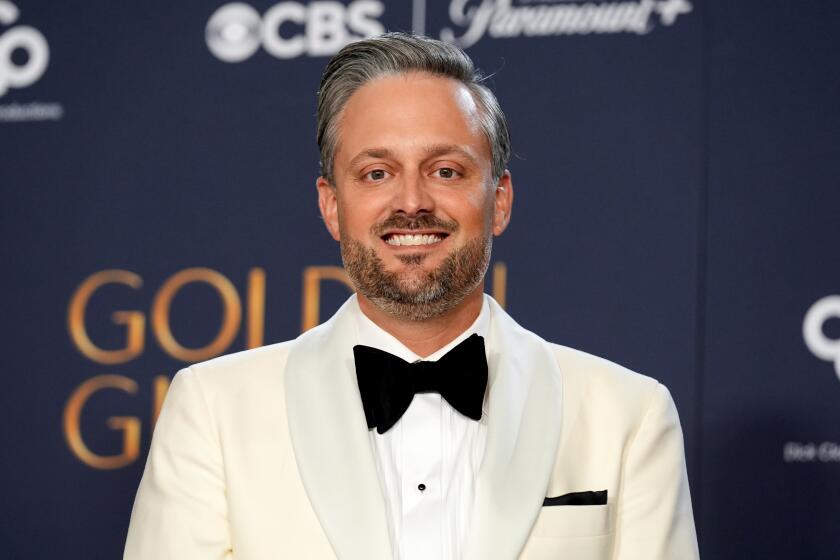HUELL HOWSER: Visiting Hours
- Share via
In his almost six years at KCET, Tennessee-born Huell Howser has established himself as Southern California’s amiable man-about-town. His “California Gold” series and Emmy-nominated “Videolog” segments have introduced viewers to a memorable collection of “real people.” On Sunday night he launches “Visiting ... with Huell Howser,” a 26-episode, half-hour interview series, inspired by the success of last year’s 10-part “Videolog Listens.” Prepping recently for the show’s premiere, Howser spoke with writer Janice Arkatov.
How did you arrive at the title for the series?
The concept behind it is that we don’t get into the hurried, fast-paced schedule of things in our city. Very seldom do any of us take the time to truly visit with one another--visiting being a somewhat old-fashioned notion of sitting down and talking with and listening to and learning about the person we’re visiting with. So it brings a sort of small-town nostalgia to the idea of Southern California in the 1990s. Visiting doesn’t just take place in a farmhouse in Nebraska; it can take place in a restaurant in South Central or outside a business in East L.A.
How do you find your subjects?
I was at the gym the other night--it was like 11:30--and I started talking to this kid (Robert Gomez) who was working out at the same machine. I said, “What are you doing here this time of night?” He said, “This is the only time I can come here.” Turns out he came to this country 14 years ago illegally--crossed the border from Mexico with his parents and sister. He works two eight-hour jobs, seven days a week, and he lives in this really bad part of town, but he says, “I’m going to make it in this country.” At that moment, I decided he’d be our first subject.
Do you ever worry that you’ll run out of interesting people?
Never! They’re all around us. We can visit schools, hang out on a corner, go to a barber shop, a bowling alley, spend the day on a sanitation truck. That’s the beauty of it. It’s a cliche, but we spend a lot of time looking for things that are right under our noses, right in our own back yard. The waiter, the bartender, the taxicab driver, the manicurist, the little lady waiting for the bus, the pizza delivery guy
The irritation I have is looking at these television shows in the afternoon--the “Oprahs” and “Geraldos” and “Maury Poviches” and “Hard Copys” and “Current Affairs”--and you think, “With all the richness in the world, why do we have to see the worst?” Day after day, every sick twisted story is what they glorify. Rather than elevate the human spirit, they bring it down.
Why do you think people feel comfortable opening up to you?
I think they understand that I’m not just there to do a story, visit with them for a few minutes, then run off. I’m genuinely interested in their stories. If someone gets a little nervous before the cameras come on, I say, “Listen, I’m not here to talk about nuclear warheads or the famine situation in Somalia. I’m here to talk about your butterfly collection, or your bonsai trees, or your family that’s been making tortillas here for 150 years. In other words, I’m going be talking about the thing that you love.”
How much preparation goes into each interview on your part?
None. I will not talk with this kid again, except to confirm the exact spot we’ll meet to do this story. I won’t ask him another question, because if I know the answer to the questions then my questions can’t be real. Instinctively, I do stories I care about--so my interest level is high. I want to hear his story.
Also, I won’t be going into any of these episodes with a particular agenda. For example, I tend to think that after you’ve watched this story, you’ll come away with the realization that the stereotype of the illegal immigrant--coming across the border and putting a drain on the welfare system and causing problems--will be shattered by this kid who works 16 hours a day in search of the American dream. But maybe it won’t. We go into each story not really knowing how it’ll turn out.
Yet it’s obviously important to you to offer these positive profiles.
I think television spends an inordinate amount of time on the sensational and the negative. I’m not one of those who thinks TV ought to reverse itself and become one big, happy newscast. But I’m convinced that if we were locked in a room and the only view we had of L.A. was what we saw on the local newscast every day, we wouldn’t want to be let out of that room.
The only thing people see about East L.A. are gang shootings, drug busts and graffiti. And all of that is there--every bit of it. But there’s also a lot more. One journalist could go out on the streets and come back with a story that says, “Look at the drugs, look at the crime, look at the despair.” I could go out and say, “Yes, look at the crime, look at the drugs ... but look at this kid-- doing what he’s doing, believing what he believes, and making it work.” It’s showing you the total picture.
“Visiting ... with Huell Howser” airs Sundays at 7:30 p.m. on KCET and repeats Saturday s at 6 p.m.
More to Read
The complete guide to home viewing
Get Screen Gab for everything about the TV shows and streaming movies everyone’s talking about.
You may occasionally receive promotional content from the Los Angeles Times.






